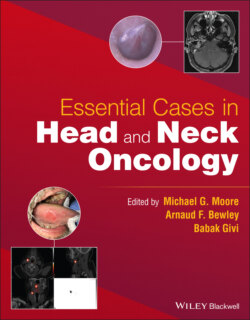Читать книгу Essential Cases in Head and Neck Oncology - Группа авторов - Страница 14
Management
ОглавлениеQuestion: What would you recommend next?
Answer: Tissue sampling with a punch or incisional biopsy of the lesion, preferably from the corner of the lesion.
Question: The biopsy shows squamous cell carcinoma (SCC ), moderately differentiated, with a depth of invasion of at least 4 mm (punch biopsy specimen with tumor transected at the base). What would you recommend next in the workup?
Answer: Imaging of the neck is usually recommended to assess lymph node involvement. A computed tomography (CT) scan with contrast or an ultrasound of the neck (which can be performed in the clinic) are both reasonable first options. The risk of distant metastases in early (T1 and T2) oral cavity SCC is extremely low. Therefore, extensive metastatic workup is not necessary. While positron emission tomography (PET)/CT has become more common, the evidence for its added benefit does not exist. Obtaining a chest CT to rule out lung metastases is considered adequate.
Question: A CT scan of the head and neck does not show any evidence of regional metastases. How would you clinically stage this disease?
Answer: Based on the AJCC staging manual, 8th Edition, the clinical stage is cT1N0Mx, stage I.
Question: What treatment would you recommend?
Answer: Early stage tongue cancer treatment is wide local excision of the primary tumor and addressing the regional lymph nodes. If the risk of regional lymph node metastases is presumed to be higher than 20%, an elective, selective neck dissection should be performed. Depth of invasion is a prognostic marker for the presence of occult nodal metastases in the cN0 neck. With a depth of invasion >3 mm, it is believed that the risk of occult nodal metastases is >20%, and therefore an elective neck dissection should be performed. In this scenario, the recommended treatment is wide local excision of the primary tumor with 1 cm margins and elective neck dissection (ipsilateral levels I–III, i.e., supra‐omohyoid neck dissection). Alternatively, sentinel node biopsy could be offered if adequate expertise in the treating facility exists.
Question: Patient undergoes sentinel node mapping followed by wide local excision and sentinel node biopsy. The tongue defect is repaired with biologic dressing and secondary intention closure. On lymphoscintigraphy, the sentinel node is located in an ipsilateral level II lymph node (Figure 1.2). Excisional biopsy and frozen section assessment shows metastatic SCC in the level II node. How would you proceed?
FIGURE 1.1 This photo demonstrates the patient's right lateral tongue ulceration.
FIGURE 1.2 This image shows the patient's fused CT‐ lymphoscintigraphy image. Note the uptake at the injection site and a right level II lymph node.
Answer: If the sentinel node is positive, completion lymphadenectomy (selective neck dissection, level I–IV) is recommended.
The patient recovers well from the operation. The final pathology report shows a 1.5 cm moderately differentiated SCC with a depth of invasion of 7 mm. All margins are free of tumor, with the closest margin being 8 mm from tumor. No lymphovascular or perineural invasion is identified. One out of 30 lymph nodes is positive for metastatic SCC without extranodal extension, measuring 1.9 cm (sentinel node).
Question: Based on these pathologic findings, what is the appropriate stage for this patient?
Answer: According to AJCC 8th Edition, tumors of the oral cavity with a depth of invasion of more than 5 mm are considered T2, even if the diameter is less than 2 cm. Therefore, the pathologic stage is pT2N1M0, stage III.
Question: What adjuvant treatment regimen, if any, would you recommend to this patient?
Answer: Since the disease is stage III, consideration of adjuvant treatment is warranted. Radiotherapy should be considered after discussion of the case at a multidisciplinary tumor board. The benefit of radiotherapy is not as clear in N1 disease; however, limited data exist that shows tumors with a depth of invasion of greater than 4 mm are at increased risk of regional failure without adjuvant therapy. Since there is no evidence of primary site positive margins or extranodal extension, there is no indication for adjuvant chemotherapy.
Question: The patient completes a course of adjuvant radiotherapy. What is your recommended regimen for follow‐up and clinical surveillance?
Answer: Based on National Comprehensive Cancer Network (NCCN ) guidelines, baseline imaging at 12 weeks after completion of adjuvant treatment should be obtained, followed by physical examination every 1–3 months in the first year post‐treatment and then 4–6 months in the second year. In years 3–5, a physical exam every 4–8 months is recommended and annually after 5 years. Annual thyroid‐stimulating hormone (TSH ) testing is recommended since the neck has received radiotherapy. Dental, nutrition, and ongoing depression evaluation are also recommended.
